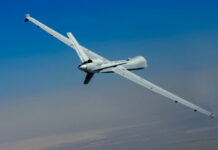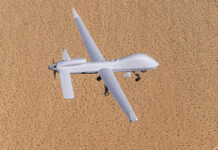General Atomics Aeronautical Systems Inc (GA-ASI) flew its XQ-67A Off-Board Sensing Station (OBSS) unmanned aerial vehicle (UAV) for the first time on 28 February 2024, the company announced the following day. The flight, which was made out of GA-ASI’s Gray Butte Flight Operations Facility near Palmdale, California, was a key milestone in a programme designed to facilitate affordable combat mass by developing several aircraft variants from a common chassis.
The OBSS is an Air Force Research Laboratory (AFRL) programme, with GA-ASI selected in 2021 to design, build and fly the new aircraft.
With flight of the AFRL-funded XQ-67A, GA-ASI has validated the ‘genus/species’ concept first developed with AFRL as part of the Low-Cost Attritable Aircraft Platform Sharing (LCAAPS) programme, which is focused on building several aircraft variants from a common core chassis.
Under LCAAPS, AFRL and GA-ASI explored development of a chassis, termed a ‘genus’, as the foundational core architecture from which several ‘species’ of aircraft can be built.
“This provides an alternative acquisition approach for military aircraft that enables faster development, lower costs and more opportunities for frequent technology refresh,” Trenton White, OBSS programme manager and aerospace engineer in AFRL’s Aerospace Systems Directorate, was quoted as saying in a GA-ASI press release. “XQ-67A is the first ‘species’ to be designed and built from this shared platform. Flight demonstration of this system is a major first step toward showing the ability to produce affordable combat mass.”
“OBSS is the first aircraft type built and flown using a common core chassis developed by GA-ASI that promotes commonality across multiple vehicle types,” added GA-ASI Vice President of Advanced Programs Michael Atwood.
The XQ-67A is the first of a second generation of autonomous collaborative platforms (ACPs) following the success of the XQ-58A Valkyrie, which was the first low-cost UAV intended to provide the US military with credible and affordable mass.
Doug Meador, ACP capability lead with the AFRL’s Aerospace Systems Directorate, was quoted in an AFRL press release as saying, “This approach will help save time and money by leveraging standard substructures and subsystems, similar to how the automotive industry builds a product line.
“From there, the genus can be built upon for other aircraft — similar to that of a vehicle frame — with the possibility of adding different aircraft kits to the frame, such as an Off-Board Sensing Station or Off-Board Weapon Station, [or OBWS],” Meador added.














